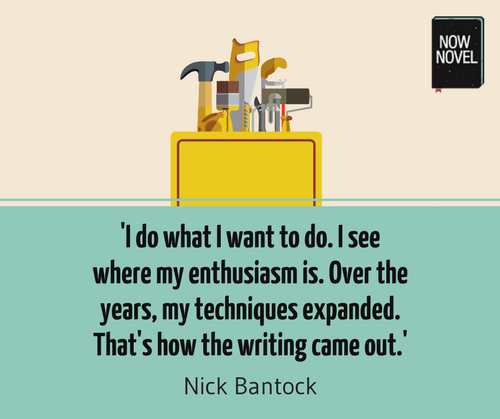Writing techniques make individual authors’ styles distinctive. From poetic devices (such as metaphor and simile) to narrative strategies, writers use various literary techniques and in doing so create their (often unmistakable) personal styles. Here are writing techniques you can use to elevate your own writing:
1. Literary techniques such as simile and metaphor
Simile and metaphor are two writing techniques that are particularly familiar to most readers.
To refresh, a simile compares two unidentical objects (e.g. ‘Her expression was as hard as a door jammed shut’).
A metaphor states that object X is object Y (the comparison words ‘like’ or ‘as [something] as’ are removed). For example, Kate Chopin describes how a lover feels about a woman’s mouth thus:
‘Her mouth was a fountain of delight.’ Kate Chopin, The Storm (1898).
Comparative devices such as simile and metaphor are essential writing techniques because they give you great creative freedom. You can compare a vast wealth of objects or images to convey the emotion and the tone of a scene.
For example, ‘her face was as hard as a door slammed shut’ strongly suggests a sense of an angry character closing off to another. Of course there’s nothing wrong with writing, ‘She closed off more, her face hard and angry.’ Yet poetic, comparative literary devices broaden your palette. You gain more ways to express the specific way a scene or character looks and feels.

2. Grammatical writing techniques
As one of the core building blocks of writing, grammar is something you might not associate with ‘creativity.’ Because there are rules that ensure a sentence makes sense, we might associate it more with dull writing ‘commandments’.
Yet the grammatical choices you make in a sentence can heighten or decrease suspense, add humour and more.
For example, consider the following grammar-related writing techniques:
Zeugma
Zeugma is a figure of speech where one word applies to two others in the same sentence, yet carries different senses or meanings.
For example, in a period romance you might read:
‘She tossed apples and jibes (disguised as compliments) over her shoulder as he pursued her, pleading, through the orchard.’
Here, the verb ‘tossed’ describes a physical throwing (the apples) as well as figurative throwing (to ‘throw’ an insult).
Often, writers use zeugma for witty, comical effect:
‘That week, his passport expired along with his patience for the pickpocketers who seemed to lurk on every beach and in every side-street.’
Parallel construction
Parallel construction is a basic device in grammar that ensures sequences of related clauses make sense and flow. Yet it can also be used to create a specific effect, where a writer repeats the same grammatical structure to create a specific tone or emphasis.
The opening to Charles Dickens’ A Tale of Two Cities (1859) is a famous example:
‘It was the best of times, it was the worst of times, it was the age of wisdom, it was the age of foolishness…’
The parallel construction of ‘it was the [idea], it was the [opposite of previous idea]’ creates the effect of a historian’s epic, sweeping, all-encompassing speech. It suggests the contradictions of the time period the story is set in.
Author C.S. Lakin has a great list here of stylistic devices you can also use to enrich your writing.
Think of these devices like seasoning; salt and pepper. Add enough to improve the whole without abusing techniques to the point they spoil the effect by making your story a device-crammed mess.

3. Narrative techniques
Narration is one of the key types of writing we have for developing a story. It’s thus worth learning common narrative techniques. For example:
Foreshadowing
We’ve covered this narrative technique in more detail here. Essentially, foreshadowing means having your narrator imply events that have yet to actually occur in the story’s unfolding narration.
For example: ‘Had we known what would happen that summer, we would not have sat in the sun that morning, feeling as though youth was forever and every summer would glow longer and more bright.’
Foreshadowing is useful for building narrative suspense. It lets you tease readers with partial information about pivotal story developments. The example above gives the reader a sense that something happens in this particular summer to disillusion a group of friends and destroy their innocence.
Flashbacks and flashforwards
These are particularly common narrative devices in stories involving character’s memories, particular ones involving strong emotion.
A flashback is where you create an alternating time sequence between a later time and past events.
For example, if an older character remembers and narrates scenes from early childhood, while the rest of your story unfolds in their present, older life.
‘Flashforwards’ are not as common. The reverse of flashbacks , they entail jumping forwards to a future imaginary or actual event.
For example, in a story where a woman is stressing about her impending wedding day, you might jump forward in time to show her imagining a worst-case-scenario:
‘I’m walking down the aisle when the train of my dress catches on something sticking up out the runner. The guests gasp as tearing sound fills the chapel and I’m there, blushing like a complete tit in my underwear.’
There’s a broad list of narrative techniques here that explains each succinctly. Practice writing scenes using different writing techniques to build your own writer’s toolkit.
Get help improving your writing through constructive critiques, or take a course to brush up on your weaker writing skills now.


7 replies on “Writing techniques to polish your prose”
In the words of Mr. Burns….EX-cellent…
Glad we could be the Smithers to your Mr. Burns, 2Cents. Thanks for reading!
Wow, never heard of zeugma before! very interesting and helpful article.
thanks
Cary
Hi Cary, thank you! I’m glad you learned something new and found this useful.
Indispensable information. Thanks for sharing.
It’s a pleasure, thanks as always for your feedback, Elias.
could you please give steps on how to come up with figures of speech , that is if it is possible